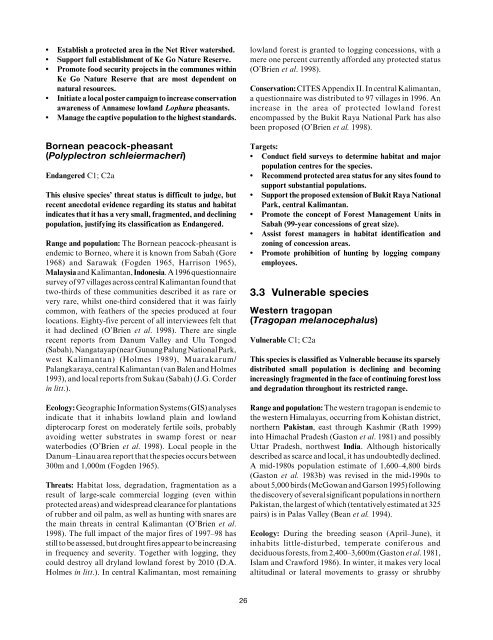Pheasants: Status Survey and Conservation Action Plan ... - IUCN
Pheasants: Status Survey and Conservation Action Plan ... - IUCN
Pheasants: Status Survey and Conservation Action Plan ... - IUCN
You also want an ePaper? Increase the reach of your titles
YUMPU automatically turns print PDFs into web optimized ePapers that Google loves.
• Establish a protected area in the Net River watershed.<br />
• Support full establishment of Ke Go Nature Reserve.<br />
• Promote food security projects in the communes within<br />
Ke Go Nature Reserve that are most dependent on<br />
natural resources.<br />
• Initiate a local poster campaign to increase conservation<br />
awareness of Annamese lowl<strong>and</strong> Lophura pheasants.<br />
• Manage the captive population to the highest st<strong>and</strong>ards.<br />
Bornean peacock-pheasant<br />
(Polyplectron schleiermacheri)<br />
Endangered C1; C2a<br />
This elusive species’ threat status is difficult to judge, but<br />
recent anecdotal evidence regarding its status <strong>and</strong> habitat<br />
indicates that it has a very small, fragmented, <strong>and</strong> declining<br />
population, justifying its classification as Endangered.<br />
Range <strong>and</strong> population: The Bornean peacock-pheasant is<br />
endemic to Borneo, where it is known from Sabah (Gore<br />
1968) <strong>and</strong> Sarawak (Fogden 1965, Harrison 1965),<br />
Malaysia <strong>and</strong> Kalimantan, Indonesia. A 1996 questionnaire<br />
survey of 97 villages across central Kalimantan found that<br />
two-thirds of these communities described it as rare or<br />
very rare, whilst one-third considered that it was fairly<br />
common, with feathers of the species produced at four<br />
locations. Eighty-five percent of all interviewees felt that<br />
it had declined (O’Brien et al. 1998). There are single<br />
recent reports from Danum Valley <strong>and</strong> Ulu Tongod<br />
(Sabah), Nangatayap (near Gunung Palung National Park,<br />
west Kalimantan) (Holmes 1989), Muarakarum/<br />
Palangkaraya, central Kalimantan (van Balen <strong>and</strong> Holmes<br />
1993), <strong>and</strong> local reports from Sukau (Sabah) (J.G. Corder<br />
in litt.).<br />
Ecology: Geographic Information Systems (GIS) analyses<br />
indicate that it inhabits lowl<strong>and</strong> plain <strong>and</strong> lowl<strong>and</strong><br />
dipterocarp forest on moderately fertile soils, probably<br />
avoiding wetter substrates in swamp forest or near<br />
waterbodies (O’Brien et al. 1998). Local people in the<br />
Danum–Linau area report that the species occurs between<br />
300m <strong>and</strong> 1,000m (Fogden 1965).<br />
Threats: Habitat loss, degradation, fragmentation as a<br />
result of large-scale commercial logging (even within<br />
protected areas) <strong>and</strong> widespread clearance for plantations<br />
of rubber <strong>and</strong> oil palm, as well as hunting with snares are<br />
the main threats in central Kalimantan (O’Brien et al.<br />
1998). The full impact of the major fires of 1997–98 has<br />
still to be assessed, but drought fires appear to be increasing<br />
in frequency <strong>and</strong> severity. Together with logging, they<br />
could destroy all dryl<strong>and</strong> lowl<strong>and</strong> forest by 2010 (D.A.<br />
Holmes in litt.). In central Kalimantan, most remaining<br />
lowl<strong>and</strong> forest is granted to logging concessions, with a<br />
mere one percent currently afforded any protected status<br />
(O’Brien et al. 1998).<br />
<strong>Conservation</strong>: CITES Appendix II. In central Kalimantan,<br />
a questionnaire was distributed to 97 villages in 1996. An<br />
increase in the area of protected lowl<strong>and</strong> forest<br />
encompassed by the Bukit Raya National Park has also<br />
been proposed (O’Brien et al. 1998).<br />
Targets:<br />
• Conduct field surveys to determine habitat <strong>and</strong> major<br />
population centres for the species.<br />
• Recommend protected area status for any sites found to<br />
support substantial populations.<br />
• Support the proposed extension of Bukit Raya National<br />
Park, central Kalimantan.<br />
• Promote the concept of Forest Management Units in<br />
Sabah (99-year concessions of great size).<br />
• Assist forest managers in habitat identification <strong>and</strong><br />
zoning of concession areas.<br />
• Promote prohibition of hunting by logging company<br />
employees.<br />
3.3 Vulnerable species<br />
Western tragopan<br />
(Tragopan melanocephalus)<br />
Vulnerable C1; C2a<br />
This species is classified as Vulnerable because its sparsely<br />
distributed small population is declining <strong>and</strong> becoming<br />
increasingly fragmented in the face of continuing forest loss<br />
<strong>and</strong> degradation throughout its restricted range.<br />
Range <strong>and</strong> population: The western tragopan is endemic to<br />
the western Himalayas, occurring from Kohistan district,<br />
northern Pakistan, east through Kashmir (Rath 1999)<br />
into Himachal Pradesh (Gaston et al. 1981) <strong>and</strong> possibly<br />
Uttar Pradesh, northwest India. Although historically<br />
described as scarce <strong>and</strong> local, it has undoubtedly declined.<br />
A mid-1980s population estimate of 1,600–4,800 birds<br />
(Gaston et al. 1983b) was revised in the mid-1990s to<br />
about 5,000 birds (McGowan <strong>and</strong> Garson 1995) following<br />
the discovery of several significant populations in northern<br />
Pakistan, the largest of which (tentatively estimated at 325<br />
pairs) is in Palas Valley (Bean et al. 1994).<br />
Ecology: During the breeding season (April–June), it<br />
inhabits little-disturbed, temperate coniferous <strong>and</strong><br />
deciduous forests, from 2,400–3,600m (Gaston et al. 1981,<br />
Islam <strong>and</strong> Crawford 1986). In winter, it makes very local<br />
altitudinal or lateral movements to grassy or shrubby<br />
26
















